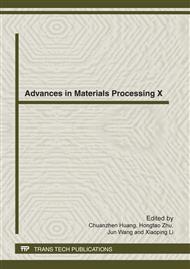p.339
p.345
p.351
p.357
p.363
p.371
p.377
p.385
p.391
Femtosecond Laser Machining of High Permeability Permalloy
Abstract:
Magnetic sensors are widely used in areas such as high-density magnetic recording, navigation, military and security, target detection and tracking, anti-theft systems, non-destructive testing, magnetic marking and labeling, geomagnetic measurements, space research, measurements of magnetic fields onboard spacecraft and biomagnetic measurements in the body 1. For magnetic sensors used to detect weak magnetic fields, a highly sensitive sensing element, with extremely high permeability, is needed. Permalloy is useful due to its initial high permeability and near-zero magnetostriction. Current fabrication methods used to produce these sensing elements include sputtering, electroplating, cold drawing and wet etching. Laser ablation, however, has always not been seriously considered due to domain pinning effects induced by nanosecond lasers2. Femtosecond laser machining, on the other hand, has shown great potential in processing such soft magnetic materials without affecting its permeability. In fact, Jia et al. had observed that when femtosecond laser micromachining was carried out on FINEMET, the amorphous phase was observed to remain in the damaged zone and few crystallization was found in the ablation zone3.
Info:
Periodical:
Pages:
363-370
Citation:
Online since:
April 2012
Authors:
Price:
Сopyright:
© 2012 Trans Tech Publications Ltd. All Rights Reserved
Share:
Citation:


